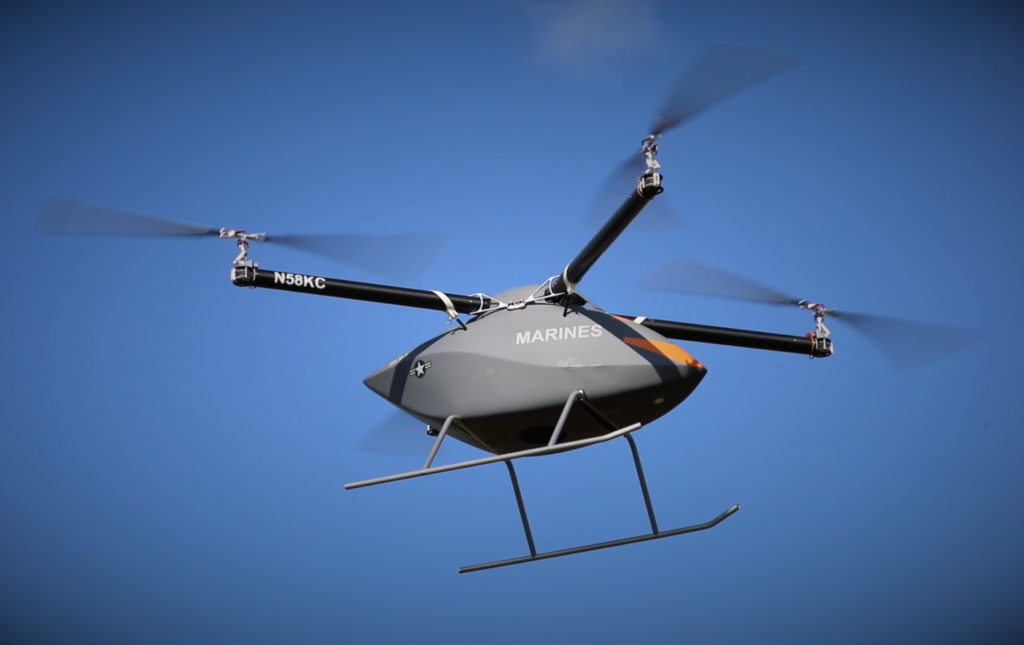Building on the success of its unmanned K-Max helicopter, Kaman is doubling down on autonomous aerial resupply, proactively developing a medium-lift platform that it believes will meet U.S. Marine Corps needs for distributed logistics, even as those requirements are still being defined.
Unveiled this week, Kaman’s quadcopter Kargo drone is designed to carry a payload of up to 800 pounds (around 360 kilograms) and self-deploy with no payload to a distance of over 500 nautical miles (925 kilometers) — putting it at the high end of the performance range the Marines are envisioning for medium-sized “unmanned logistics systems – air” (ULS-A). Kargo can also fit in a standard shipping container and be unloaded by as few as two people, maximizing its possibilities for deployment.
“We feel really strongly that we’re hitting center target relative to the size, scale, capabilities and performance of this vehicle, knowing full well that things are still evolving,” Kaman CEO Ian Walsh told Vertical. “The Marines were very clear about how they wanted to deploy this, and it is designed to be simple.”
The Marines envision using small, medium and large ULS-A — in conjunction with conventional crewed aircraft — to support expeditionary advanced base operations in the years to come. As part of that plan, they have partnered with the U.S. Air Force’s Agility Prime effort to explore potential military uses for a new generation of electric vertical take-off and landing (eVTOL) aircraft.
For Kargo, however, Kaman deliberately avoided electric and hybrid-electric architectures. Powered by a 300-horsepower turbine engine, the aircraft uses conventional transmission technology to drive its four teetering rotor systems. According to Romin Dasmalchi, Kaman’s senior director of business development, government, the idea is to use proven technology that the military is capable of sustaining now.

“While we know that eVTOL is probably the future, we also know the rigors of combat, and these operating concepts that are going to be in a maritime environment, that are going to be connecting these forces across great distances — it calls for no-kidding trustworthy equipment, and things that are ready to go on a moment’s notice,” he said.
“Of course, the flip side of that is in a distributed environment, you don’t want to be a large consumer of fuel,” Dasmalchi acknowledged. For that reason, he said, Kaman will be using a very fuel-efficient engine, although the company has yet to name its supplier. Meanwhile, the Kargo airframe can “absolutely” be adapted to electric or hybrid solutions in the future, Walsh said, noting that the company has already been flying an electric half-scale demonstrator.
For autonomous systems, the company has partnered with Pennsylvania-based Near Earth Autonomy, which is also working with Kaman on the latest version of the unmanned K-Max. Adapted from Kaman’s commercial, piloted K-Max helicopter — which can carry up to 6,000 lb. (2,720 kg) as an underslung load — the first generation of unmanned K-Maxes flew missions for the Marine Corps in Afghanistan between 2011 and 2013. The aircraft were credited with moving over 4.5 million lb. (2 million kg) of cargo between forward operating bases and remote outposts during their time in the country, but relied on remote pilots and GPS waypoints to reach their destinations.
Over the past decade, autonomous technologies have progressed significantly. The various sensors in Near Earth’s autonomy package will enable both the K-Max and Kargo to “fly safe, land safe [and] do it without GPS, even when things go wrong,” as Near Earth CEO Sanjiv Singh described it. That means being able to navigate around obstacles like antennas and trees and identify suitable landing zones without relying on human input or GPS. Such capabilities are especially valuable for expeditionary logistics because “you’re never just running the same route over and over,” Singh pointed out.

According to Walsh, Kaman progressed from the initial concept for Kargo to a half-scale demonstrator and full-scale mockup in just nine months. The company is already working on a full-scale flying prototype, which it expects to begin testing next year.
“We’re going to move relatively quickly,” Walsh said. For now, Kaman is funding the project internally, but “at some point we expect our customers to step in and help us get it the rest of the way,” he told Vertical.
Exactly how that might happen remains to be seen. “We certainly are not interested in going through a massive slow bureaucratic acquisition process because, quite frankly, this doesn’t sit at that level,” he said. “The intent is to get to a level of readiness that [customers] are able to then decide how they want to track it.”








